As of 1 p.m. on Tuesday, April 21, there were 134,874 known cases of COVID-19 in New York City and 35,746 people were or had been hospitalized. There were 9,562 confirmed deaths and an additional 4,865 suspected deaths for a possible total of 14,427 fatalities.
Wednesday, April 22, 2:30 p.m.
A couple weeks ago, Mayor de Blasio foresaw a moment where New York City’s hospitals would run out of ventilators and doctors would have to decide who lived or died—where people might perish in one of the richest cities in the world for want of a suitcase-sized machine.
That crisis appears to have passed. “But having gone through that terrifying moment, I can tell you, I am determined to make sure that New York City never ever is in a situation in the future where we need ventilators and we can’t get them. We have to protect our people,” he said Tuesday, as he unveiled a plan for a consortium of local companies to manufacture 3,000 bridge ventilators, which would provide support to patients who need help breathing but are not yet sick enough for a full ventilator, buying doctors life-saving moments.
“This is something we now have that can never be taken away from us. This is something we make here that no one else in the world can deprive us of,” the mayor said. “We are now increasingly self-sufficient. We’ve got a long way to go, but this is a remarkable achievement.”
De Blasio was similarly effusive earlier this month when he toured factories at the Brooklyn Navy Yard that were making masks and gowns to bulk up the stretched supplies of personal protective equipment at city hospitals.
The discussion of local manufacturing as an essential civic good adds to the mayor’s mixed record on supporting local industrial firms.
Under de Blasio’s predecessor, Michael Bloomberg, the city lost about 4,050 acres of land zoned for manufacturing land between 2002 and 2015. During his second year in office, the De Blasio administration released a comprehensive 10-point plan to boost manufacturing, including hundreds of millions of dollars of support for city-owned manufacturing hubs. City Hall has also taken steps to limit the intrusion of hotels and self-storage space onto city-owned land.
However, several of the de Blasio rezonings have shrunk the acreage devoted to manufacturing. The pending Gowanus rezoning has been scrutinized for its potential impact on the adjacent industrial business zone. The Bushwick rezoning, now on ice because of a dispute with local officials, would have exposed so-called M-land to more pressure. The Industry City plan raised similar concerns. And the administration authored a North Brooklyn Industry and Innovation Plan that opens some manufacturing areas to more competition from office space.
“The story of City Hall and local manufacturers collaborating to address the COVID threat is a great success story,” says Adam Friedman, director of the Pratt Center for Community Development. “But for that type of collaboration to happen again in a future that may be more threatening because of both disease and climate change, the city needs to do two things: It needs to pause its rezonings and other practices that take away space for manufacturing, and it needs to support the soft infrastructure of industrial service organizations that pull together the hospitals and other buyers with the local producers.”
People Detained for Parole Violations Still at Risk, Advocates Say
Sunday, April 19, 8:50 a.m.
The state’s parole system, which criminal-justice reformers tried and failed to reform last year, is emerging as a key obstacle to reducing density behind bars as COVID-19 continues to kill hundreds of New Yorkers each day.
Last spring, in the wake of sweeping reforms earlier in 2019 to New York’s bail laws, advocates lobbied state lawmakers to reform the system by which people on parole are sent to jail on charges that they had violated technical rules of their release. That reform was seen as an indispensable move to reduce the population on Rikers Island as part of the city’s plan to shutter the island’s jails and open borough-based facilities instead.
Albany did not deliver change. Now, despite the release of more than 1,400 people from the city’s jails since the onset of COVID-19, concern remains about unnecessary detentions, and it largely focuses on the parolee population. In a report released on Saturday, the Lippman Commission—the body whose 2017 report paved the way for the Close Rikers plan—emphasized the parolee population as it exhorted the city and state to do more to protect people in jails from the coronavirus.
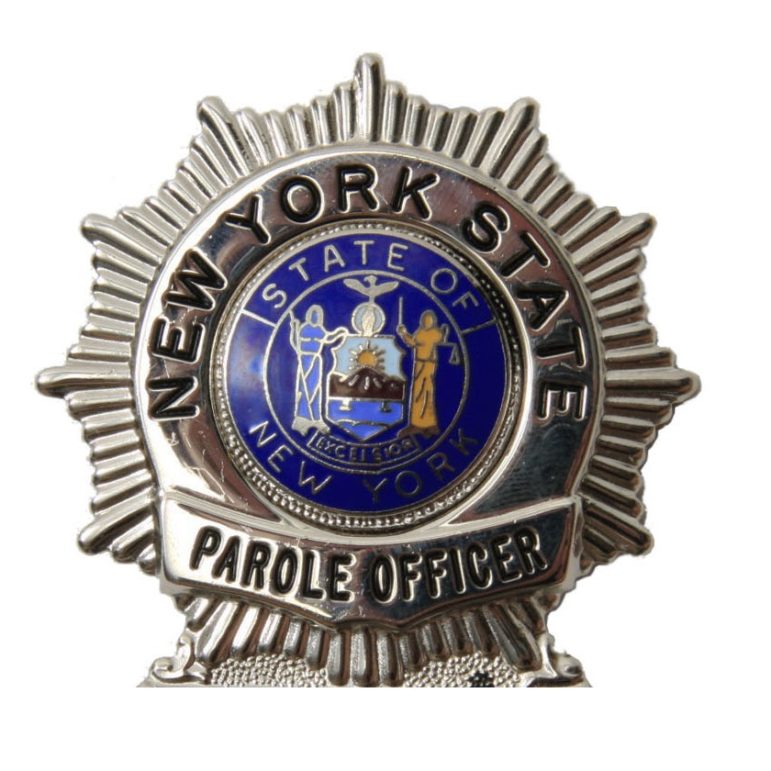
squarespace.com
“Almost a quarter (24 percent) of the people in New York City jails are held on parole warrants issued by State DOCCS, which is the only agency that has the authority to release these people,” the report read, referring to the Department of Corrections and Community Supervision. While Gov. Cuomo did in late March order the release of 400 people held in city jails on state parole warrants, the Lippman Commission said only 260 actually got out, because “DOCCS excluded many people from release under this process, including those diagnosed with serious mental illness.”
What’s more, “Since March 27, DOCCS has incarcerated more than 30 new people at Rikers due to allegations of technical parole violations.”
There are two sets of alleged parole violators held in city jails. Some are held on a technical violation of parole rules, while others have a new arrest on a penal-law violation or crime.
The first group includes 272 people at last count, 90 percent of whom are Black or Latino and 75 percent of whom are held in minimum or medium security. Thirty-nine of them are aged 50 or older and 29 of them were brought in after April 1—in other words, well after the city began to reduce jail population.
The second group is larger, encompassing 650 detainees, 90 percent of whom are Black or Latino, 113 of whom are aged 50 or older and 61 of whom were picked up on or after April 1. The second group is more likely to be held under stricter conditions: 55 percent are held in minimum or medium security.
While many of the people in that group are accused of serious charges—like rape, robbery or murder—there are also parolees held on charges like criminal trespass, petit larceny and fourth-degree possession of stolen property. Fifty are in on drug possession charges. According to the Lippman Commission’s report, half of this second group are “incarcerated on charges that are not authorized for pretrial detention under current state law, absent a parole warrant,” meaning they’d be free awaiting trial were it not for their parole status.
The commission called on the state to stop new parole-related arrests, release parolees held on technical violations or on criminal charges that wouldn’t typically justify pre-trial detention, and allow the parolees held on more serious charges to go before a judge for a decision about whether detention, bail or release is warranted.
The panel also called on the city and district attorneys to release more of the regular population of pre-trial detainees, which is by far the largest segment of the Rikers population. It further recommended more measures to prevent the spread of infection among people who remain incarcerated. According to the commission, over 1,000 workers and incarcerated people in the jails have tested positive for the virus and 12 (nine staff and three incarcerated people) have died.
Meanwhile, concerns also persist about conditions in state and federal correctional facilities.
The state Department of Corrections and Community Supervision told City Limits on Friday that only 307 of its 43,000 inmates had been tested for COVID-19. As of Saturday, 204 inmates had tested positive, and 49 were already recovered.
More than 750 staff members and 29 parolees had also tested positive. As of Saturday, five incarcerated people, four people on parole and one staffer had died of the virus. DOCCS wouldn’t say whether county medical examiners were investigating other inmate deaths for COVID-19.
And the city’s Bar Association last Wednesday spotlighted the federal jail and prison system. “Federal judges in New York continue to examine cases individually, resulting in the release of only a handful of individuals on bail or by way of compassionate release,” the organization said in a statement. “The growth rate of the positive COVID-19 tests in federal prisons (even without widescale testing) … is alarming, yet no alarms seem to be going off in U.S. Attorney’s offices.” -Murphy
COVID’s Fiscal Impact Comes Into Focus in Mayor’s Budget
Friday, April 17, 7:29 a.m.
As the coronavirus continues to claim thousands of New Yorkers’ lives, efforts to slow the spread of the virus have strained New York City’s resources and drained revenues. Mayor de Blasio cited an estimated tax revenue loss of $7.4 billion for the city over this and next fiscal year when he briefed the public Thursday morning.
De Blasio said Thursday, “The executive budget I’m presenting today was built for this moment in history and a moment unlike any other … [It] focuses on four things overwhelmingly: health, safety, food, shelter.”
The new budget totals $89.3 billion, with more than $2 billion in cuts. These cuts include service reductions for 50 municipal initiatives, but programs serving the city’s youth incurred some of the most significant cuts. The closure of public schools allowed New York City to reduce spending on education to the tune of millions. However, because of the city’s tight finances, these cuts will go toward balancing the budget rather than being redistributed to other or new initiatives serving young residents.
Michelle Jackson, the Human Services Council’s acting executive director, said in a statement, “The budget cuts the mayor announced today are clearly and sadly concentrated on services for the youngest New Yorkers.” While the youth and educational services cut in the new budget would typically take place in group settings, Jackson emphasized that “New York City’s youth need comprehensive programming, particularly now that schools have been closed.”
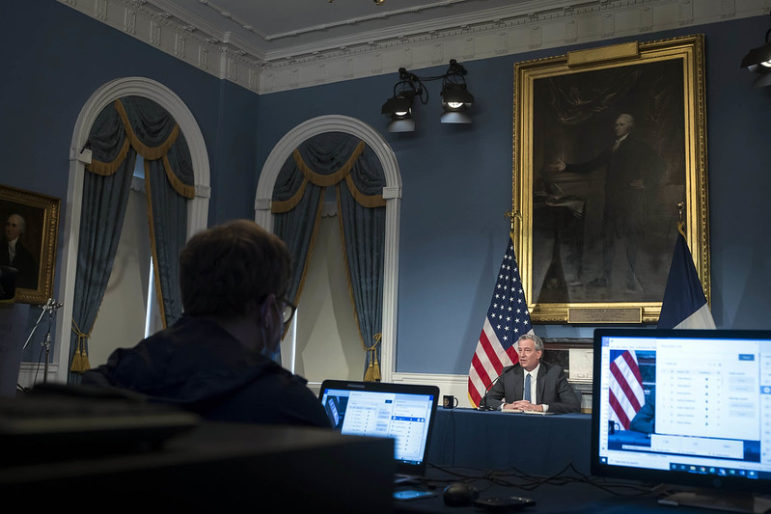
Ed Reed/Mayoral Photography Office
Mayor Bill de Blasio holds a media availability on COVID-19. City Hall. Thursday, April 16, 2020.The Campaign for Children released a statement echoing Jackson’s sentiment, stating, “Youth services not only enhance the social and emotional well-being of our children, but they are necessary to achieving some sense of normalcy when we emerge from the pandemic. These programs will be vital to the well-being of families and to our larger economic recovery.”
De Blasio also called on President Trump to support aid for local governments, including New York City which has had to make difficult decisions in order to balance its budget. The new budget draws from the city’s savings too, including $900 million from the general reserve. During his briefing on Thursday, the mayor said, “I spoke to the president yesterday. I let him know we’re experiencing a huge budget problem. I was clear with him and the vice president that the only way to recovery is if New York City and all our cities are able to come back strong. ” He added, “If they can’t function, there is no recovery.”
The mayor also announced that New York City would make 11,000 hotel rooms available for people who need to isolate and quarantine, starting this coming Wednesday. The intention behind this effort is to reduce the spread of coronavirus among family members and de Blasio noted that the city will continue making hotel rooms available for health care workers as well. –Nicole Javorsky
Mayor Announces $170M Plan to Address Hunger During Coronavirus Crisis
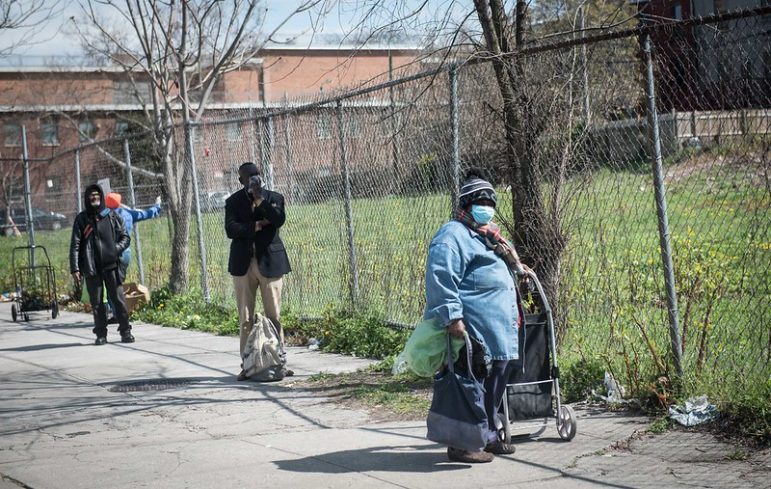
Michael Appleton/Mayoral Photography Office
Mayor Blasio visits the Campaign Against Hunger food pantry in Brooklyn on Tuesday.Wednesday, April 15, 6:46 p.m.
In his morning briefing on Wednesday, Mayor Bill de Blasio explained how the city will help New Yorkers who are struggling to get meals as the coronavirus continues to rattle the economy. The city is allocating $170 million, including $25 million in funding for emergency food providers across the boroughs, to address the issue of hunger, intensified by COVID-19.
“Whatever savings people have [are] running low,” de Blasio said Wednesday. “A lot of people already have run out of money. And yes, there’s some help that’s coming in. We all appreciate that for sure, but we all know it’s not enough to sustain people.”
New York City is delivering 25,000 meals each day now to older New Yorkers who used to get their meals from senior centers. The city’s emergency food delivery program for New Yorkers who live in public housing or who are particularly vulnerable because of their age or pre-existing medical issues is also serving 100,000 meals daily.
“So, for more and more New Yorkers, we’re hearing this all the time, people are literally asking, where’s my next meal coming from? That’s something painful to consider in the greatest city in the world,” De Blasio said.
Because the public health crisis has led to many losing their jobs and increasing economic stress for those who already faced food insecurity prior, the city is trying to expand its capacity for providing meals free of charge to those who need it. To meet the increasing level of need, the city has registered 11,000 drivers, who are licensed by the NYC Taxi and Limousine Commission and who have seen their earnings dissipate as the virus spread.
Part of the plan sets aside $50 million to build up a reserve food supply for the city, funding 18 million shelf-stable meals. The mayor also issued new guidance for stores to require customers to wear facing coverings while shopping inside. When asked about enforcement, de Blasio said, “We have to be clear. This is another one of the things we have to do to protect each other. Anytime the NYPD or any of our agencies are needed to help enforce, they’ll be there.”
Gov. Andrew Cuomo announced his own statewide executive order that requires all people in New York wear masks or face coverings when out in public, particularly in situations where social distancing might not be possible, such as on public transportation.
-Nicole Javorsky
New Calls for Action to Protect Inmates as Death Rate Inches Up
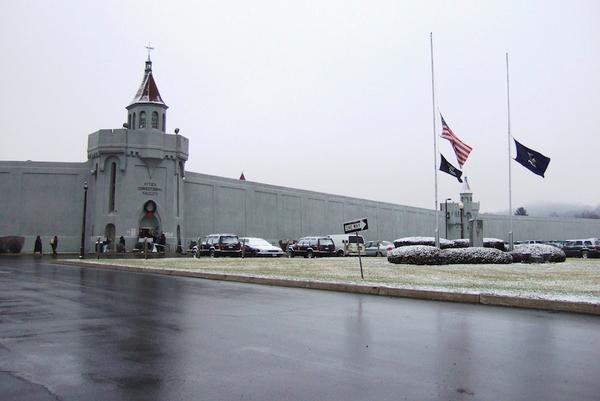
Jayu
Attica Correctional FacilityWednesday, April 15, 12:30 p.m.
The toll of COVID-19 in the state’s prison system grew Wednesday as the Department of Corrections and Community Supervision (DOCCS) announced a fifth confirmed inmate death of the disease.
One staff member and four parolees have also succumbed to the virus. A total of 850 staff members, inmates and parolees have tested positive for it.
Deaths within the prison system remain relatively low compared with the city—which has confirmed 6,589 deaths and considers COVID-19 a probable cause of 3,778 others—or the state, which has recorded 10,834 deaths using a different system than the city’s. Of course, the number of people involved in the prison system (about 107,000 when staff, inmates and parolees are added up) is far smaller than the population of the city or state, the death rate within the DOCCS system of 9.3 per 100,000 people is lower than the statewide rate of 55.7 per 100,000.
The concerns, however, are forward looking. Advocates have been worried from the outset of the crisis about the potential of COVID-19 to devastate jails and prisons, where a disproportionate number of medically fragile people often live in crowded conditions. Gov. Cuomo ordered the release of 1,100 people held on parole violations in prisons and jails, 400 of whom were in New York City jails. Mayor de Blasio and district attorneys facilitated the release of 700 additional prisoners awaiting trial or serving misdemeanor sentences.
“There’s five cases but there’s the potential for literally thousands,” says David George, a spokesperson for the Release Aging People in Prison campaign. George also expressed doubts that DOCCS statistics were capturing the true scope of COVID-19 in the system: It is curious, for instance, that the rate of infection among correctional staff is six times higher than that of the inmates they supervise.
Several celebrities, including John Legend and Joaquin Phoenix, have called on Cuomo to grant broader clemency. The Legal Aid Society has called for the release of 105 prisoners. “Many have release dates that are only weeks away,” attorneys Stefen Short and David Loftis wrote in a letter to the governor on April 6. “Given the exponential spread of the virus, this could mean the difference between life and death.”
DOCCS doesn’t disclose which of its prisons have been affected by deaths or host confirmed cases.
The New York City Bar Association on Friday called for stronger action on all three levels of government. It recommended the city do more to release people held on bail. “At the state level, we urge that much more be done – and faster – to follow neighboring states and reduce jail and prison populations,” the association wrote. “On the federal side, far greater urgency is required. Despite repeated calls by the Federal Defenders and the U.S. House of Representatives, testing and releasing incarcerated individuals is lagging well behind the need for quick and decisive action.”
-Jarrett Murphy
Mayor: Schools Will Operate Online for the Rest of the Year

Ed Reed/Mayoral Photography Office.
Mayor Bill de Blasio holds a media availability on COVID-19. City Hall. Friday, March 27, 2020.Saturday, April 11, 2020
Mayor de Blasio announced Saturday that New York City public schools would operate online for the rest of the school year, which is scheduled to end June 26.
The announcement came nearly four weeks after de Blasio on March 15 reluctantly closed the schools through April 19. Gov. Cuomo announced earlier this week that schools statewide would be closed through April 29.
“This is a public health decision — and not an easy one. But it’s the right one. The social distancing strategies have been working, and we cannot risk a resurgence of the virus, de Blasio tweeted. Noting that he had spoken with Dr. Anthony Fauci, the director of the National Institute of Allergy and Infectious Diseases. “Our health experts believe this is the safest, best approach.”
“COVID-19 has been challenging for every New Yorker, but it’s been especially difficult on our kids. They’re resilient, but this is traumatic. Too many of them have lost someone they love. Each of them has lost normalcy. Everything we do next for our schools will be for them,” de Blasio continued.
The mayor promised one-on-one support for graduating seniors, and new activities for student engagement. In an acknowledgement that there were still gaps in online learning, and that they could persist for weeks, de Blasio promised: “We will complete deliveries of internet enabled digital devices for every student who needs them for remote learning. This will be complete before the end of April.”
-Jarrett Murphy
Mayor Sketches Plan for Moving Out of Crisis Mode
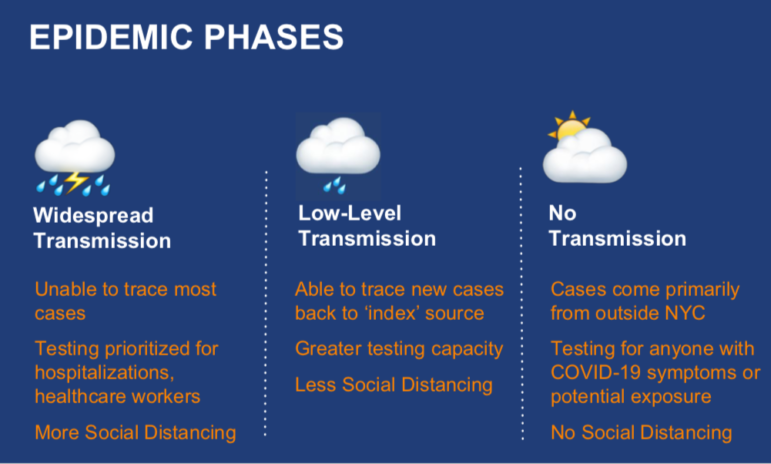
Thursday, April 9, 12:11 p.m.
A cautious Mayor de Blasio on Thursday outlined a two-stage process for life in New York City to return to normal after weeks of death and disruption caused by COVID-19.
The mayor said the city could at some point in May or June move to relax some social-distancing measures, and at some point after that end all the restrictions that were put in place to arrest the spread of the coronavirus.
De Blasio repeatedly qualified the plan, however, indicating that disease-control measures might need to be reimposed if infections accelerate again. “The last thing we can afford is to let down our guard and let this disease back in the door,” he said. He stressed that New Yorkers had to stay vigilant and comply with social-distancing rules. “We need to win our way to the next phase. Obviously, we have a long way to go.”
The city is now in a phase of “widespread transmission,” according to the mayor. The next phase would be one of “low-level transmission,” when there are so few new cases that the city’s disease detectives can actually trace each one. That period could come in May or June and would involve some relaxing of the social-distancing restrictions—although the mayor didn’t say which ones would be relaxed, and indicated that different rules might be tightened and loosened at different points. “People have to be smart about it and not overdo,” he said. Having access to testing would be key to this phase so that new cases could be quickly isolated.
The mayor said the move toward a “low-level transmission” posture would be governed by 10 days to two weeks of consistent decreases in the number of people admitted to hospitals for suspected COVID-19, the number of people admitted to hospital ICUs for suspected COVID-19 and the percentage of people tested who are positive for COVID-19. “We need to see a clean clear pattern that sustains itself for several weeks,” he said.
The third phase, which the mayor said is months away, is a period of “no transmission”–when the only new cases of COVID-19 are among people infected elsewhere who travel to the city. In that phase, all social distancing rules would be ended.
Perhaps the biggest decision facing the city is whether and when to reopen schools. De Blasio said Thursday that there are discussions underway about that, and indicated that he sees one last chance for in-person learning to resume again this school year. -Jarrett Murphy
COVID-19 is Disproportionately Killing NYC’s Latinos and Blacks

Wednesday, April 8, 11:22 a.m.
COVID-19 is disproportionately killing Latinos and Blacks, Mayor de Blasio disclosed on Wednesday, pledging a new outreach effort to address vulnerable communities.
Of the deaths from the coronavirus so far 34 percent have been Latinos and 28 percent Blacks—compared with their population shares of 29 percent and 22 percent, respectively. Whites and Asians are underrepresented: 27 percent and 7 percent of deaths versus 32 percent and 14 percent of the population, respectively.
Those numbers are based on death certificates and represent only the data from two thirds of the fatalities so far, according to health commissioner Dr. Oxiris Barbot.
The death data “tracks with other profound healthcare disparities that we have seen for years and decades in this city,” de Blasio said. “We’re going to have to find a way to get healthcare workers out into their communities,” the mayor added. A plan to do so “in a safe, smart, strategic way” would be revealed “in the coming days.”
From the earliest days of the crisis, the city has released detailed data on the gender, age and borough of residence of people who tested positive, were hospitalized or died. As reports from other cities about stark racial disparities in the disease’s impact, calls grew in New York for more attention to a likely racial skew. “Knowing which communities are most heavily impacted by COVID-19 is challenging when there is no data available for which racial demographics are testing positive, needing hospitalization, recovering from COVID-19, and dying as a result of COVID-19,” Public Advocate Jumaane Williams wrote last week in a letter to the mayor and health commissioner. “Tracking and publishing this data is critical to facilitating the allocation and distribution of resources to the areas most in need.”
It’s not the first time in the crisis that the administration has been criticized for a lack of transparency in the data it was releasing: The mayor scolded reporters for asking about geographic details on COVID-19’s impact, before releasing it. De Blasio has said that data collection is not the primary focus of the city’s pandemic response, and that he has been reluctant to reveal numbers that incomplete on unconfirmed. “If you’re going tell people something you’d better damn well be right about it,” he said Wednesday.
The mayor blamed the racial skew on the inherent problems in a health system where employment and income influences access to care. “Until we get to some form of universal healthcare, this danger will exist,” he said. “We should be worried about the future. This is not the last time we’re going to hear about a new disease.”
Barbot noted that “where we are seeing these inequalities are places and populations that have historically had higher rates of underlying chronic illness,” making the Latino and Black communities more vulnerable. She also expressed concerns about the role that might have been played by xenophobic rhetoric and policies. “The overlay of the anti-immigrant rhetoric across this country, I think has real implications for the health of our communities.”
Dr. Mitchell Katz, the head of the public hospital system, suggested that the greater likelihood of people of color to live in multigenerational and multifamily households, because of the cost of housing. In such a setting, transmission would be more likely. -Jarrett Murphy
NYS’s Deadliest Day Amid Signs of Slowdown, SYEP Canned
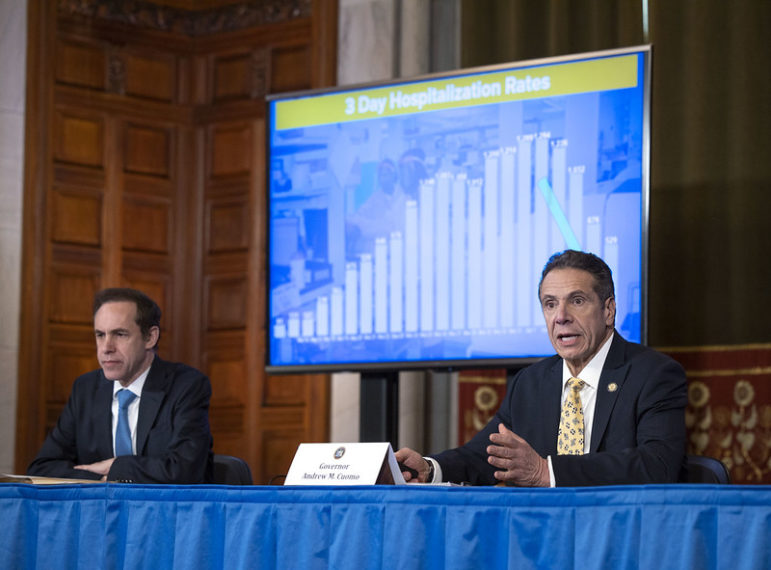
Tuesday, April 7, 2:45 p.m.
The de Blasio administration cancelled the Summer Youth Employment Program for 2020 on Tuesday, despite desperate pleas by advocates to give digital options a chance to save a key source of income and work experience for low-income teenagers.
Meanwhile, Gov. Cuomo announced that 731 people died in New York State over the past 24 hours, making for the deadliest day yet. Trends in hospitalizations, however, continued to hint that the virus was plateauing.
SYEP provides six weeks of minimum-wage work for young people aged 16 to 24, and career training and internship experience for 14- and 15-year-olds. Last year 151,000 kids applied for 75,000 slots.
“Out of an abundance of caution for our young people, providers and worksites, we have made the very difficult decision not to operate the Summer Youth Employment Program this year,” Department of Youth and Community Development Commissioner Bill Chong said in a letter to providers.
“SYEP has been a New York City institution since 1963 so we did not arrive at this decision easily,” Chong continued. “Unfortunately, the uncertainty over how COVID-19 will continue to affect social distancing guidelines, worksite availability, and provider and site staffing as we head into late spring and summer makes it difficult to ensure that SYEP can be operated safely and efficiently.”
But advocates work was well underway to create digital methods to deliver the program, which at the very least would have offered some engagement for kids who could very likely not be in a classroom until after Labor Day.
Lazar Treschan, vice president for policy and impact at the youth engagement organization Here to Here, called the move “dishonest and shortsighted.”
“Programs have already communicated they could run it remotely. This is just balancing budgets on the backs of poor NYers–young people, with the fewest resources to fight back.”
SYEP would have been an attractive target for budget-cutters because it is funded primarily by city money and its costs hit early in fiscal year 2021, when city coffers are likeliest to be dry.
While the New York State death toll has now reached 5,489, there are signs that new, serious infections are slowing. Hospitalizations jumped from 358 on April 5-6 to 656 on April 6-7 but the latter was the third straight day with fewer than 1,000 new hospitalizations (the level that had been recorded for much of the previous two weeks). Intensive-care unit admissions fell to 89 from 128 the day before, and intubations dropped to 69 from 132. Death numbers might climb even after a peak or plateau is reached, Cuomo said, because death is a “lagging indicator.”
New York City’s death toll passed 3,000 and kept climbing overnight. If 2017’s vital statistics are any guide, the 3,202-person New York City toll as of 9:30 a.m. Tuesday ranked COVID-19 as the third-leading cause of death in city over the entire year, behind heart disease and cancer, although closer scrutiny of the data indicate that the coronavirus has already caused more deaths than most individual forms of cancer do over 12 months. -Jarrett Murphy

Economic Pain Spreads Throughout New York State
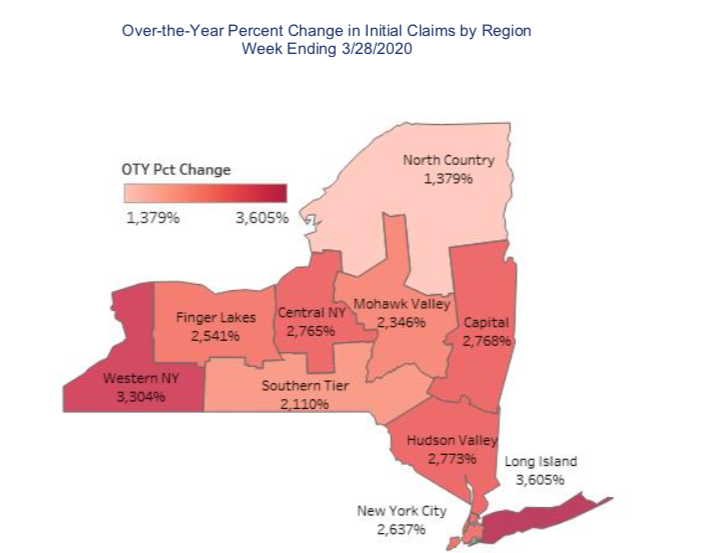
Monday, April 6, 3:20 p.m.
New York City is the epicenter of the COVID-19 crisis in the country, with more than half the positive cases in New York State.
But data released by the state Department of Labor on unemployment claims in the week ending March 28 indicates that, while the sheer numbers of job losses are staggering in the downstate area, the largest percentage loss of jobs is highest north and west of the city.
The tables below compare the number of new claims the week ending March 28 with the same week last year, in raw-number and percentage terms. -Jarrett Murphy
| County | Gain in unemployment claims vs. 2019 |
| Queens | 43,127 |
| Kings | 41,955 |
| Suffolk | 28,325 |
| Erie | 24,852 |
| New York | 23,597 |
| Nassau | 22,651 |
| Bronx | 22,619 |
| Monroe | 15,379 |
| Westchester | 13,042 |
| Onondaga | 9,474 |
| County | Percentage gain in unemployment claims vs. 2019 |
| Washington | 5,911% |
| Tompkins | 5,844% |
| Saratoga | 4,814% |
| Steuben | 3,892% |
| Nassau | 3,839% |
| Niagara | 3,795% |
| Schuyler | 3,740% |
| Queens | 3,532% |
| Onondaga | 3,509% |
| Madison | 3,469% |
Push to Expand Summer Youth Jobs, if They can be Saved
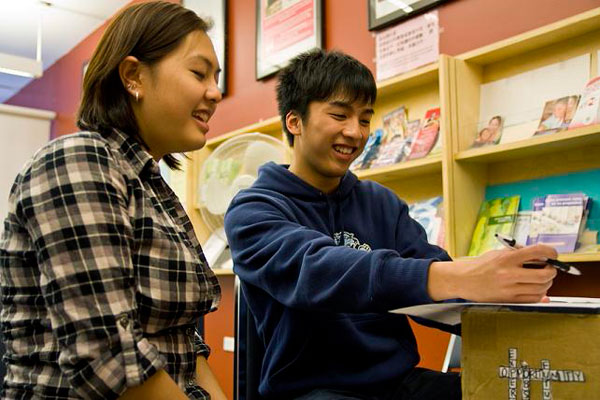
Monday, April 6, 12:00 p.m.
Advocates are pushing to expand the Summer Youth Employment Program, amid concerns it faces the de Blasio administration’s budget axe as the city struggles to balance its books amid the COVID-19 crisis.
SYEP has been a feature of the New York City summer for decades. Participants who are 14 or 15 take career readiness courses, do site visits and participate in a service project or a $700 stipend. Participants aged 16 to 24 work 25 hours a week at minimum wage for six weeks, earning $1500. Last summer SYEP served 74,500 city teenagers.
Besides offering work experience, the program is a valuable income source to families. Last year there were twice as many applications as slots.
“I know for a fact there are families that depend on SYEP money,” says Troy Burton, the internship director at DreamYard, a Bronx youth-development nonprofit. “Not for extras. Not for vacations. This helps them get by.”
Sources tell City Limits that the city’s Office of Management and Budget identified the program as a target for cuts because the $134 million cost hits early in the fiscal year, which begins in July. That is when the city is most likely to be cash poor as the revenue shortfalls resulting from the economic shutdown hit.
The program is usually delivered in person in July and August, a period when it is possible that social distancing rules will still be in place.
City Hall wouldn’t comment, but sources say the administration initially wanted to use its emergency powers to cut the $160 million program ($132 million came from city funds in 2019, the rest from federal and state support and private donations). It now appears the administration will negotiate with the City Council over the program’s future.
Meanwhile, aggressive efforts are underway to develop a digital version of the program.
“Since early March, we’ve also been working with other SYEP partners and a team of youth advisors on how to most effectively transform in-person program components, including the in-person orientations and provider trainings that normally would be happening this month, into 100 percent virtual experiences Leah Potter of Hats and Ladders, a career-development ap creator, told City Limits. “We’re confident that there’s ample time for organizations who provide SYEP programming to come together (remotely!) in the coming weeks to put together a mix of digital experiences that would provide quality and really meaningful work readiness experiences for youth, even if they understandably can’t be placed at work sites this summer.”
“I think the all-virtual option is entirely possible,” said one nonprofit leader involved in the work. “Maybe it wouldn’t be a ‘job’ job, maybe it’d be certification.”
If social distancing is in place over the summer, the digital model will work, the leader said. If the social prohibitions are lifted, SYEP participants could be provided free to businesses trying to get back on their feet. But if the program is canned, neither option will be available. Applications are underway now.
If nothing else, the program would be a way to keep students somewhat engaged during what could be a long, strange, unsettled summer. Participants would have to be online for some number of hours, giving them something to do. “We need some way to keep these kids connected,” the leader said.
On March 14, explaining some of his concerns about shutting down schools and libraries, de Blasio articulated a similar concern. “We want our young people to be safe,” he said then. “I don’t think anyone wants to see a bunch of young people outside getting into other types of danger. So now what are you going to take away from them? “
There might even be a chance to expand the program this summer, since the overhead costs for providing a virtual program ought to be less than the in-person version. Even if the pay for 16-year-olds and older kids were cut to $700, the program could still have real value to students and families.
To that end, a petition circulating Monday called on Mayor de Blasio to expand SYEP this summer. “In the event that social distancing measures remain in place in July and August, community-based organizations are ready to rise to challenge of providing meaningful remote work opportunities,” the petition email read. “Now is the time to pull together to support young people and families with every tool we have!”
In 2009, Mayor Bloomberg used federal stimulus funds to expand SYEP in midst of a fiscal crisis. Advocates are hopeful de Blasio will expand the program without waiting for federal funding.
‘Our Lives Were Turned Upside Down’
Monday, April 6, 9:20 a.m.
Unlike perhaps any event in memory, everyone has a coronavirus story. A story is more than merely recalling where you were when you heard the news (that JFK had been shot, that the Challenger had explored, that planes had hit the Twin Towers and Pentagon). A story involves a personal impact, a way you’ve been changed not by choice but by circumstance.
City Limits has been collecting those stories through an online survey. They are a wholly unscientific sampling of New Yorkers’ experiences during the crisis, and they reflect both the unequal fortunes people enjoyed or endured before the virus and the uneven impact of the disease itself.
Below is a testimonial from a teenager in Queens. It’s not the worst tale of woe this episode will produce, not by a long shot. No one dies. It does, however, reflect the way life is being reframed by COVID-19:
“I am a high school senior living in New York City. This semester for many of us, was supposed to fulfill many of the aspirations that we have in mind when we think of Senior Year. Prom, Graduation, College Day, all of these days are supposed to be there to recognize what we have been working for up until that moment. A few weeks ago, I was opening up college letters. I applied to 18; if that sounds ridiculous, it is. Each of them gave me the opportunity to experience new things in life. This was the one thing I was focused on, everything else seemed unimportant. I was accepted to 16 of them. I could not believe that I had choice in the matter; my mindset had been that I was going to be rejected by most. Since then, my father has lost his job and my mother is struggling to make ends meet. Our world, like many others, was turned upside down. Having an unemployed parent in a crucial time like this is now becoming a norm. I am now stuck with the decision: Should I continue down the private college path, the one that I dreamed about since freshman year? That would entail the risk of taking out close to $200,000 in student loans and my inability to rely on my parents. It’s funny how quickly life can change. I was so worried about getting into the best schools, now I am just worried about even being able go to one of these schools. I now realize there are so many other issues that I have to focus on, supporting my parents, making sure that my grandmother is safe. College and the norm of high-school life has now become an afterthought. That’s just how impactful this virus has been.”
Mayor Says City is in ‘a Race Against Time’
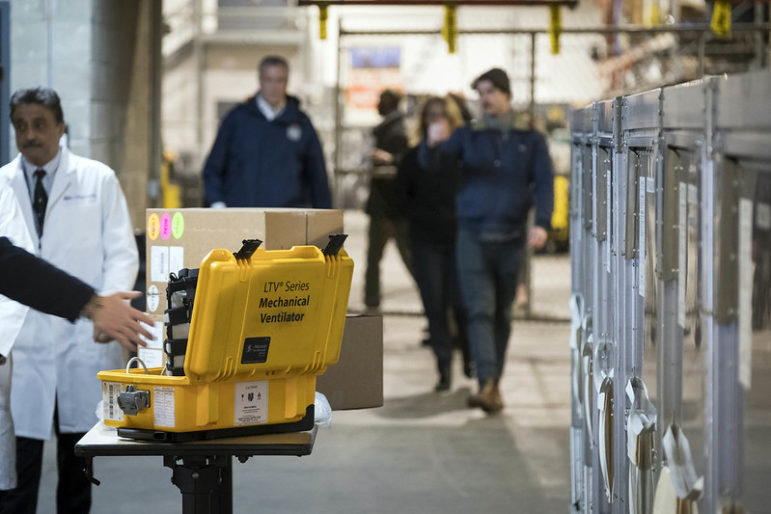
Ed Reed/Mayoral Photography Office.
One of the precious ventilators that city hospitals will need in large numbers over the next days.Friday, April 3, 5:24 p.m.
With the city in what he called a “race against time,” Mayor de Blasio called Friday for a national enlistment program for medical workers and ordered cops and firefighters compel businesses and people hoarding life-saving medical equipment.
“We are beginning now a race against time,” de Blasio said, noting as he has for several days that he believes Sunday, April 5, “is absolutely an essential day”—essentially the point where New York City could have more desperately ill patients than ventilators or the staff the can operate them. De Blasio said the city needed 2500 to 3000 ventilators by that date.
Earlier in the day, Gov. Cuomo said he would issue an executive order to take ventilators “from institutions that don’t currently need them and redeploy the equipment to other hospitals with the highest need,” according to a statement from the governor’s office. “The National Guard will be used to transport the ventilators and [personal protective equipment] across the state. The equipment will be returned to the hospital or the hospital will be reimbursed for the equipment in the future,” Cuomo’s office added.
The mayor said he expected most people and firms to comply. “But in the event that any private organization or individual attempts to resist this new instruction from the state and does not provide those crucial, life-saving supplies and equipment, then I am authorizing the NYPD, the sheriffs and the FDNY to use the law enforcement authority to ensure those supplies are brought to where the need is greatest in our hospital system,”the mayor said.
On Thursday the mayor had alluded to the need for a “draft” of medical personnel. Friday he called instead for a “national enlistment effort,” for civilians, and he repeated his call for military medical personnel to be sent to New York and other COVID-19 hotspots. “Right now there’s a peacetime approach in Washington and that wont cut it,” he said. The city’s pre-crisis clinical staffing was 125,000; the mayor said some 3,600 of the city’s projected 45,000-person need had been met through contracting.
Also Friday:
• The mayor said the number of people released from Rikers Island and other city jails during the crisis had passed 1,000.
• The state prison system announced that 201 employees, 36 inmates and 13 parolees had tested positive and that four deaths were now linked to the coronavirus—a civilian employee, a parolee and two inmates, although confirmation of cause of death was pending in at least some of those cases.
• The Department of Buildings released a real-time map of essential construction sites around the city.
• Comptroller Scott Stringer released a letter he’d sent on Thursday to the Family Court system calling for several steps to protect domestic violence victims during the COVID-19 crisis. A few hours later, the comptroller announced that his 86-year-old mother, Arlene Stringer-Cuevas, had succumbed to the disease.
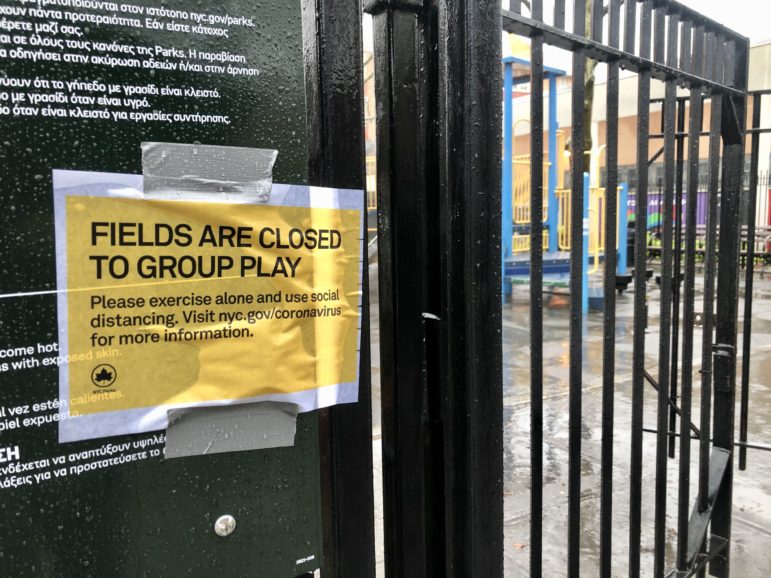
Jeanmarie Evelly
The playground at Athens Square Park bore a sign asking visitors to exercise alone.Parks Dept. Signals Funding Freeze to Nonprofits
Friday, April 3, 9:22 a.m.
Nonprofit organizations that run public programs and perform key maintenance work in city parkland are concerned that the de Blasio administration is abruptly cutting off funding amid the budget crunch triggered by the coronavirus crisis.
“We are living in unprecedented times as the city grapples to lower ‘the curve’ during this COVID-19 event and keep New Yorkers safe,” Brett Meaney, the Parks Department’s director of contracts, wrote to his agency’s nonprofit partners last Friday. “Because of fiscal and other uncertainties in the coming months, Parks is advising nonprofits to cease any future spending on your Fiscal Year 2020 discretionary awards as those expenses may not be reimbursable.”
Leaders at two of those nonprofits say the directive could force organizations to lay off staff—especially since the money Meaney refers to might have been spent already. Organizations tend to spend their city money early in the fiscal year so they can file on time the required year-end reports accounting for the cash. In order to deliver promised services, nonprofits might even have to spend money before a city contract comes in, because of pervasive delays in the contracting process.
With only three months left in the current fiscal year, it is unlikely that many nonprofits actually have much spending they could forego, the leaders said.
Among the organizations that received discretionary funding from City Councilmembers in the budget passed last June were Fort Greene Park Conservancy, Bronx River Alliance, Brooklyn Alliance of Neighborhood Gardens Land Trust, Gowanus Conservancy, City Parks Foundation, Forest Park Trust and Friends of Crotona Park and Greenbelt Conservancy among others.
The organizations typically combine city funding with private donations and foundation grants, and some garner state and federal support. The city discretionary money might not be a major revenue source, but it can be an important part of particular employees’ salaries.
“We are deeply troubled to hear that parks conservancies and parks partner organizations are being told by the city to freeze spending and not use the remaining discretionary funding that they were allocated in the city’s Fiscal Year 2020 budget,” says Emily Walker, director of outreach & programs at New Yorkers for Parks. “New Yorkers across the city are seeking refuge in their parks as we grapple with the COVID-19 pandemic. Now is not the time to treat them as something we can do without.”
The Parks Department did not provide comment.
Sources tell City Limits the department has also frozen any non-COVID-related purchasing, which could indicate concerns about cash flow.
The focus of concern now is the remainder of the current fiscal year. There’s also ample angst, however, about what Fiscal 2021 will look like. Many parks nonprofits hire seasonal staff whose tenures straddle the end of one fiscal year and the beginning of the next one.
“People are pretty sick thinking about what that agency is going to look like,” one nonprofit leader says.
The cuts could imperil an expansion of the Parks Department’s own staffing that advocates won after years of efforts to get deeper and more equitable funding for the agency, which maintains a huge portion of the city’s footprint with a relatively small headcount. According to data from the Independent Budget Office, the Parks Department had 4,019 full-time positions last year, fewer than the Administration for Children’s Services, Department of Environmental Protection or CUNY.
Walker says 340 frontline Parks staff positions are set to expire on July 1. “These positions were created last year because of the efforts of New Yorkers for Parks and the Play Fair Coalition, and they do the essential work of keeping parks safe and well-maintained.” Their work might be even more important this summer, she says, as parks could see record attendance once social distancing is relaxed.
“Once it is finally safe to be together in large groups again, New York City parks are going to be more in-demand than ever,” Walker says. “The city needs to ensure that conservancies and parks partner organizations have the resources that they were promised, for the good of all New Yorkers.”
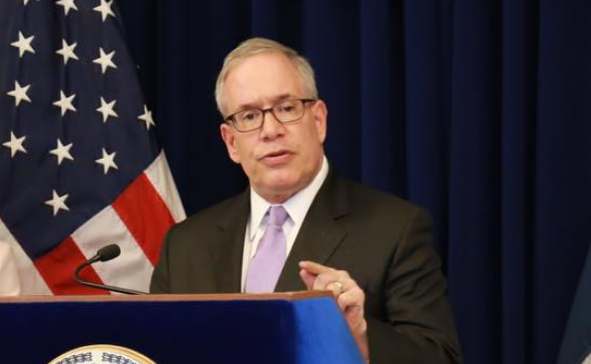
Office of the Comptroller
Comptroller Scott StringerTuesday, March 31, 2020, 3:50 p.m.
Legislation to cancel rent for residents and businesses hurt by the COVID-19 crisis gained the support of Council Speaker Corey Johnson and Comptroller Scott Stringer on Tuesday. Twenty-two Democratic state senators also back the measure authored by Mike Gianaris of Queens.
That bill stipulates that “any residential tenant or small business commercial tenant in the state that has lost income or has been forced to close their place of business as a result of government ordered restrictions in response to the outbreak of coronavirus disease 2019 (COVID-19), shall have all rent payments suspended for 90 days following the effective date of this act.”
Under the law, the waived rent would never be charged, nor would any late fees. Leases that lapse during the 90 days would automatically renew. The law would also mandate forgiveness of mortgage payments by landlords who face “financial hardship” as a result of the rent cancellation.
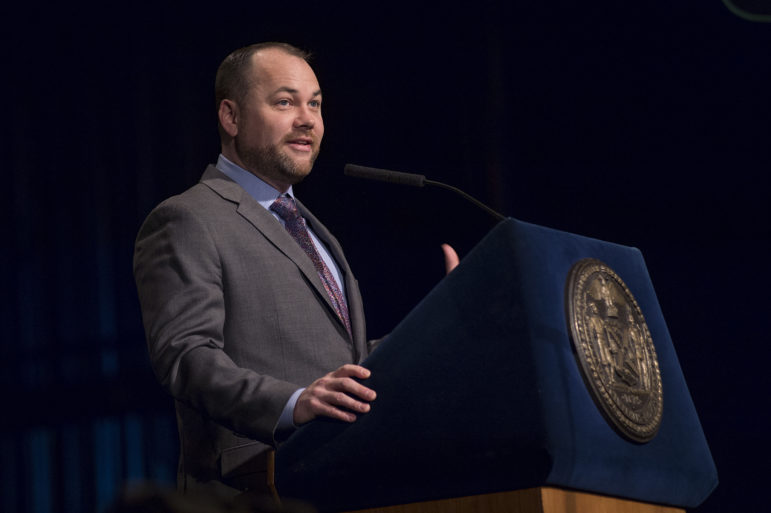
Jeff Reed/City Council
Speaker Johnson“We need rent relief for those impacted by this crisis,” Johnson said in a statement. “We need to balance rent relief with financial support for building owners whose tenants are suffering, especially small, mom and pop landlords and non-profit building owners. We should consider whether we should—in some cases–extend temporary tax relief to those landlords so that they can get through this period. “
Stringer tweeted support for the notion as well.
As New Yorkers face unprecedented economic turmoil, the rent is due tomorrow.
— Scott M. Stringer (@NYCComptroller) March 31, 2020
Our office found that more than 572,000 NYC households are severely rent-burdened, paying more than 50% of their income on rent.
What are they supposed to do? #CancelRent https://t.co/f3nJAGbQR1
Mayor de Blasio has called not for rent cancellation but for a freeze on rent-stabilized rents, which would be achieved by cancelling this year’s Rent Guidelines Board process. City Hall did not respond to a request for the mayor’s position on rent cancellation.
Both the Gianaris proposal and the mayor’s call go beyond the eviction moratorium imposed by the governor by executive order. While the governor’s order prohibits evictions for non-payment of rent over the next three months, the unpaid rent would be due at the end of that period.
De Blasio’s proposed rent-freeze would not protect tenants unable to afford their current rent. It would apply to all rent-stabilized tenants, whether or not they could demonstrate a financial impact from COVID, but not to non-stabilized renters or to commercial tenants. Gianaris’ proposal would mean no rent for those impacted by the crisis, regardless of whether they were stabilized or not, and would also affect commercial tenants, but would end after three months, while the mayor’s approach would likely last a year.
Meanwhile, the Right to Counsel Coalition and Housing Justice for All are planning to release on Wednesday a toolkit for how to perform a rent strike. “Rent is due tomorrow. Thousands can’t pay rent, but Cuomo has yet to cancel rent,” the coalition said in a statement. “Our only and best option is to organize!”
Frank Ricci of the Rent Stabilization Association, which represents property owners, dismissed the discussion.
“Rent cancellation and rent strikes are nothing more than cheap political opportunism at their worst,” he said, via email. “If society feels that rent cancellations are necessary than there should be a dollar for dollar reduction in real property tax for affected owners. This way everyone bares the cost. We’re all in this together, right?”
Unemployment Insurance System Buffeted by Calls and Clicks
Tuesday, March 31, 3:30 p.m.
The state Department of Labor received 8.2 million phone calls last week, a 16,000 percent increase over a typical week and its online filing system garnered 3.4 million visits, a 900 percent boost in traffic, the agency said on Tuesday.
DOL is asking New Yorkers to only file claims on days associated with their name:
- Monday: Last name starts A-F
- Tuesday: Last name starts G-N
- Wednesday: Last name starts O-Z
- Thursday, Friday, Saturday: all last names
The agency has devoted hundreds of staff members to the effort, begun considering claims on Sundays, and increased its hours:
- Monday through Thursday, 8:00 AM to 7:30 PM
- Friday, 8:00 AM to 6:00 PM
- Saturdays, 7:30 AM to 8:00 PM
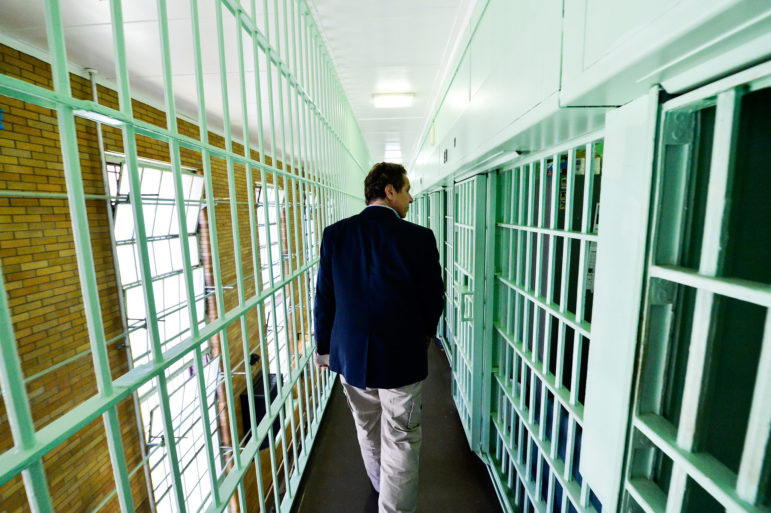
Office of the Governor
Governor Cuomo tours Clinton Correctional Facility in Dannemora in 2015.Broad Clemency Sought as COVID Hits State Prisons
Tuesday, March 31, 8:35 a.m.
As the number of coronavirus cases in New York State neared 67,000 on Monday, Gov. Cuomo came under new pressure to move vulnerable inmates out of state prisons.
“We write today to urge you to use your full authority as governor to release as many people as possible from incarceration for the duration of the pandemic, focusing on people who are especially vulnerable to infection,” read a letter to Cuomo from three officials at the Brennan Center for Justice. “The scope of this pandemic presents extraordinary challenges to state and local officials, including prison officials, law enforcement, and those responsible for our systems of justice.”
Cuomo approved the release last week of 1,100 people held in prisons and local jails on technical parole violations, 600 of whom were held by New York City. That order, along with moves by the city to release people serving time for misdemeanors and by district attorneys to release people awaiting trial, helped free at least 860 people from Rikers Island and other city lock-ups since the COVID-19 crisis began.
According to Brennan, however, as many at 10,000 of the 40,000 people in state prisons could be at risk from COVID-19 because of their age. That’s why they want Cuomo to grant clemency to prisoners identified as being at risk, expand “merit time” so that a broad segment of the prison population has a stronger incentive to behave well so they can achieve earlier release and encourage prosecutors around the state to refrain from sentencing people to prison during the crisis. The letter argued:
The clemency power was created to extend mercy to those convicted of crimes. The public health epidemic we currently face in New York calls for the kind of rapid relief that only clemency can offer. Writing in the Federalist Papers, Alexander Hamilton, himself a New Yorker, drew on colonial law and English precedent to argue that the federal clemency power should be “as little fettered or embarrassed,” and used proactively in “critical moments” to defuse tension.8 COVID-19 has already started to spread in our state’s prison system, necessitating quick action, and the clemency power gives you the authority to respond humanely.
DOCCS told City Limits on Tuesday morning that 123 of the department’s 29,000-employee workforce had confirmed cases, as did 14 of 43,000 people in prison and nine of the state’s 35,000 parolees.
“With each confirmed case, DOCCS works with the Department of Health to identify any potentially exposed individuals to provide notifications and to stop the spread of the virus,” a spokesperson said.
Also Monday, a coalition including the Release Aging People in Prison campaign and the Parole Preparation Project called on Cuomo to grant clemency broadly, but also to ensure those paroled are safe as they re-enter society, and to eliminate risks within the parole system itself, like in-person check-ins for parolees. The coalition also demanded better conditions inside prisons.
“Releasing people from prison, especially those who have served long sentences and are aging or elderly, strengthens our families, ensures the overall well-being of our communities, and allows us to thrive,” the coalition said. If officials don’t act, “they condemn all those in prison, both the people incarcerated and those charged with their care, to prolonged sickness and, in many cases, death.”
The Legal Aid Society and Prisoners’ Legal Services have made similar calls.
Cuomo, whose past approach to clemency has been criticized, said on Monday he was considering some action along those lines.
Meanwhile, COVID-19 has sharpened the debate about whether to roll back last year’s bail reforms amid a conservative backlash claiming the elimination of cash bail for many offenses has led to an uptick in crime. Supporters of bail reform held a virtual rally on Monday and released a letter signed by 40 legislators and a statement by 200 advocacy groups calling on the governor and legislature to refrain from altering the 2019 reforms.
Mayor Calls for Immediate Rent ‘Freeze’
Saturday, March 28, 10:20 a.m.

Ed Reed/Mayoral Photography Office.
Mayor Bill de Blasio holds a media availability on COVID-19. City Hall. Friday, March 27, 2020.Mayor de Blasio on Friday called for an immediate rent freeze in the city, effectively asking the state to suspend the annual process that establishes guidelines for the city’s nearly 1 million rent-stabilized apartments.
City Hall also said on Friday that 450 people had been released from city jails since the start of the crisis. That total includes people serving city sentences, whom the mayor released on his own authority, and pretrial detainees who were released with the permission of the district attorney overseeing their case. Separately, Gov. Cuomo ordered the release of 1,100 people detained in local jails on parole violations. Published reports indicate 400 of them are in New York City jails.
Amid predictions that as many as half a million New Yorkers would lose their jobs amid the economic wreckage of the coronavirus crisis, there is wide concern that a new, more serious housing crisis is looming. Cuomo has already established a 90-day moratorium on evicting tenants for non-payment of rent and taken steps to forestall foreclosure. Some advocates have called for more dramatic action, like the government “cancelling” rent payments, so that tenants affected by the crisis don’t face an accumulation of bills once the moratorium lifts. There have also been calls for a rent strike.
Landlords counter that unless property taxes and water fees are also suspended, any significant reduction in rent payments could drive them into the red.
Rent-stabilized apartments house around 2 million New Yorkers. The laws and regulations governing the system are overseen by the state, but annual decisions about rent increases are made by a city entity the Rent Guidelines Board.
When he became mayor, de Blasio called for a “rent freeze”–a decision by the RGB that rents on stabilized apartments should remain flat. The RGB, which is largely controlled by the mayor, complied in 2015 and 2016. Since then, the RGB has approved rent hikes on one-year leases of 1.25 percent in 2017, 1.5 percent in 2018 and 1.5 percent in 2019.
The RGB renders its decision after holding hearings in each borough. This year’s process would have been the first carried out under the broad rent reforms adopted by the state legislature last year, which sharply limited other mechanisms stabilized landlords had for raising the rent.
RGB usually announces its decision in late June. De Blasio, however, wants the freeze imposed immediately by suspending the RGB process altogether. The mayor told reporters:
I think if ever there was a time, there should be a rent freeze, it is now. So, for the millions of New Yorkers who live in a stabilize rent, stabilized housing in this city, normally you wait until later in the spring for the Rent Guidelines Board to make its decision on what rent levels should be for the upcoming leases. What we’ve seen here, to me, makes clear that we need a rent freeze for everyone who’s rent stabilized and we have to talk about all the people who are not rent stabilized as well. But for everyone, who is rent stabilized, since we have a mechanism, we need to have a rent freeze. But the only way to do that is with the help of the State of New York. And I would like to see the state immediately join with us and they’ve been very cooperative on so many fronts. We’ve worked on so many issues together and come to a common agreement on the way forward. So, we will be working with the State starting immediately, requesting the opportunity to suspend the rent guidelines process for calendar year 2020. If we are able to get State agreement to suspend the rent guidelines process for this year that will effectively create an immediate rent freeze for new leases, that’s something I think we have to do given the sheer severity of this crisis.
It was unclear whether that act would require an act of the state legislature or if the state Division of Homes and Community Renewal could achieve it though an order.










13 thoughts on “The Coronavirus Thread: Local Manufacturing, Buffeted by Development, Gets COVID-19 Spotlight”
My local Stop-N-Shop had about two days of panic buying but yesterday (Sunday 3-15-20) was pretty much back to normal. Plenty of produce, low on meat though. This was in the late afternoon however. They stock up overnight and in the early mornings. I didn’t go in this morning but the parking lot had a lot of empty spaces at 10am which means the store wasn’t crowded.
‘In a statement released shortly thereafter, the Legal Aid Society’s Tina Luongo said: “City Hall must place an immediate moratorium on arrests…’
I have never heard anything so absolutely ill-advised and stupid.
NYC Corona Virus count as of 3/17/20 approx 5pm –
COUNT | BORO | % OF NYC TOT | square miles | avg cases per sqmi
96 | Bronx | 11.79% | 42.10 | 2.280
157 | Brooklyn | 19.29% | 70.82 | 2.217
277 | Manhattan | 34.03% | 22.83 | 12.133
248 | Queens | 30.47% | 108.53 | 2.285
36 | Staten Island | 4.42% | 58.37 | 0.617
814 | NYC TOT| 100.00% | 302.65 | 2.690
I have a small barbershop in up state ny iv shut the shop down all my barbers are not working Can I as an owner do one person at a time by appointment only ?
I work in a call center for blue cross in Middletown, N.Y. I often work from home but now they’re mandating I come in to a crowded office. How do I report a company forcing ppl to work against the shutdown order?
NYC Corona Virus count as of 3/23/2020 approx 1pm –
COUNT | BORO | % OF NYC TOT | square miles | avg cases per sqmi
1829 | Bronx | 14.83% | 42.10 | 43.44
3494 | Brooklyn | 28.33% | 70.82 | 49.34
2572 | Manhattan | 20.85% | 22.83 | 112.66
3621 | Queens | 29.36% | 108.53 | 33.36
817 | Staten Island | 6.62% | 58.37 | 14.00
12333 | NYC | 100.00% | 302.65 | 40.75
My Mother and Father are in their 70’s, they are both considered essential workers with whom are not in the medical field. I am 39 also an essential worker, I do work in the medical field. What is our city doing to protect our seniors? Seniors considered essential workers should have a choice to work or not! As a medical professional I have steered clear of my entire family for over a month now, but it is extremely stressful knowing both my parents are putting themselves at risk everyday and I have no way to protect them. If anyone can please share advice or thoughts on this issue, I would sincerely appreciate it. Thank you! Sending well wishes to all!!
Why there is no numbers coronavirus cases for 5 boroughs separately on 3/23/2020?
Please put the number out let all of us see what is happening now everyday. It is just like all other statistics for the whole US, whole world, and whole China. Thank you!
Just added it to the top …
As of 5 p.m. on Monday, March 23, there were 12,339 known cases of COVID-19 in New York City (The Bronx: 1,829 Brooklyn: 3,494 Manhattan: 2,572 Queens: 3,621 Staten Island: 817) and 99 deaths had been recorded.
Is cleaning an Airbnb essential
I don’t think all warehouses Or distributions should be essential I work in one and there’s nothing essential about it. First they told us we could take the time off without being fired now they are threatening to fire us. This is a little ridiculous I live at home with my
Mother who is highly at risk and my 1.5 year old son. I would
Like to feel safe.
New York wants to use up everyone’s resources have all are health care professionals go there get infected. Leaves everyone else shorter on staff then we already are. How is this gonna work?????
When Katrina struck New Orleans, New York City sent firefighters to help. When Houston was inundated, NYC responders went to pitch in. New York State sent firefighters to help Australia with its wildfires. It sent state troopers to drive supplies around Puerto Rico after Maria. I donate money to the Red Cross after tornadoes in the South. All of these are resources that we know we might need some day, right in our own city or state or pocket. But we share them for two reasons: It is the humane thing to do. And it recognizes that if we allow part of our society, however distant, to fall apart, that is one less bit of infrastructure for us to rely on when we are in need.
I wish it weren’t so, but wherever you live, this virus is going to come your way — whether your local health staff helps here or not. When COVID-19 does arrive near you, do you want a New York City health system that’s ready to send some nurses and doctors your way to pitch in, or one that is so decimated by provider illness and death, or so overwhelmed by patients, that it can’t?